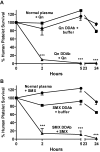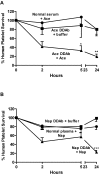Drug-dependent clearance of human platelets in the NOD/scid mouse by antibodies from patients with drug-induced immune thrombocytopenia
- PMID: 20587782
- PMCID: PMC2974608
- DOI: 10.1182/blood-2010-03-277764
Drug-dependent clearance of human platelets in the NOD/scid mouse by antibodies from patients with drug-induced immune thrombocytopenia
Abstract
Drug-induced immune thrombocytopenia (DITP) is a relatively common and sometimes life-threatening condition caused by antibodies that bind avidly to platelets only when drug is present. How drug-dependent antibodies (DDAbs) are induced and how drugs promote their interaction with platelets are poorly understood, and methods for detecting DDAbs are suboptimal. A small animal model of DITP could provide a new tool for addressing these and other questions concerning pathogenesis and diagnosis. We examined whether the nonobese diabetic/severe combined immunodeficient (NOD/scid) mouse, which lacks xenoantibodies and therefore allows infused human platelets to circulate, can be used to study drug-dependent clearance of platelets by DDAbs in vivo. In this report, we show that the NOD/scid model is suitable for this purpose and describe studies to optimize its sensitivity for drug-dependent human antibody detection. We further show that the mouse can produce metabolites of acetaminophen and naproxen for which certain drug-dependent antibodies are specific in quantities sufficient to enable these antibodies to cause platelet destruction. The findings indicate that the NOD/scid mouse can provide a unique tool for studying DITP pathogenesis and may be particularly valuable for identifying metabolite-specific antibodies capable of causing immune thrombocytopenia or hemolytic anemia.
Figures






Similar articles
-
Drug-induced thrombocytopenia: development of a novel NOD/SCID mouse model to evaluate clearance of circulating platelets by drug-dependent antibodies and the efficacy of IVIG.Blood. 2010 Sep 16;116(11):1958-60. doi: 10.1182/blood-2010-02-268326. Epub 2010 Jun 21. Blood. 2010. PMID: 20566900
-
Structural basis for quinine-dependent antibody binding to platelet integrin αIIbβ3.Blood. 2015 Oct 29;126(18):2138-45. doi: 10.1182/blood-2015-04-639351. Epub 2015 Aug 17. Blood. 2015. PMID: 26282540 Free PMC article.
-
Quinine-dependent, platelet-reactive monoclonals mimic antibodies found in patients with quinine-induced immune thrombocytopenia.Blood. 2009 Jan 29;113(5):1105-11. doi: 10.1182/blood-2008-09-177279. Epub 2008 Oct 23. Blood. 2009. PMID: 18948570 Free PMC article.
-
Pathophysiology and Diagnosis of Drug-Induced Immune Thrombocytopenia.J Clin Med. 2020 Jul 13;9(7):2212. doi: 10.3390/jcm9072212. J Clin Med. 2020. PMID: 32668640 Free PMC article. Review.
-
Approach to the diagnosis and management of drug-induced immune thrombocytopenia.Transfus Med Rev. 2013 Jul;27(3):137-45. doi: 10.1016/j.tmrv.2013.05.005. Epub 2013 Jul 8. Transfus Med Rev. 2013. PMID: 23845922 Free PMC article. Review.
Cited by
-
CD8+ T cells mediate antibody-independent platelet clearance in mice.Blood. 2016 Apr 7;127(14):1823-7. doi: 10.1182/blood-2015-10-673426. Epub 2016 Jan 19. Blood. 2016. PMID: 26787734 Free PMC article.
-
Construction and in vivo/in vitro evaluation of a nanoporous ion-responsive targeted drug delivery system for recombinant human interferon α-2b delivery.Int J Nanomedicine. 2019 Jul 16;14:5339-5353. doi: 10.2147/IJN.S209646. eCollection 2019. Int J Nanomedicine. 2019. PMID: 31409991 Free PMC article.
-
Prevalence and clinical significance of low-avidity HPA-1a antibodies in women exposed to HPA-1a during pregnancy.Transfusion. 2013 Jun;53(6):1309-18. doi: 10.1111/j.1537-2995.2012.03903.x. Epub 2012 Sep 25. Transfusion. 2013. PMID: 23003125 Free PMC article.
-
Immune destruction of human platelets in the NOD/scid mouse.Transfusion. 2016 Oct;56(10):2648-2649. doi: 10.1111/trf.13746. Transfusion. 2016. PMID: 27739154 Free PMC article.
-
Recommendations for the use of the non-obese diabetic/severe combined immunodeficiency mouse model in autoimmune and drug-induced thrombocytopenia: communication from the SSC of the ISTH.J Thromb Haemost. 2015 May;13(5):872-5. doi: 10.1111/jth.12879. Epub 2015 Mar 28. J Thromb Haemost. 2015. PMID: 25714467 Free PMC article. No abstract available.
References
-
- Aster RH, Bougie DW. Drug-induced immune thrombocytopenia. N Engl J Med. 2007;357(6):580–587. - PubMed
-
- Swisher KK, Li X, Vesely SK, George JN. Drug-induced thrombocytopenia: an updated systematic review, 2008. Drug Saf. 2009;32(1):85–86. - PubMed
-
- George JN, Raskob GE, Shah SR, et al. Drug-induced thrombocytopenia: a systematic review of published case reports. Ann Intern Med. 1998;129(11):886–890. - PubMed
Publication types
MeSH terms
Substances
Grants and funding
LinkOut - more resources
Full Text Sources
Other Literature Sources

